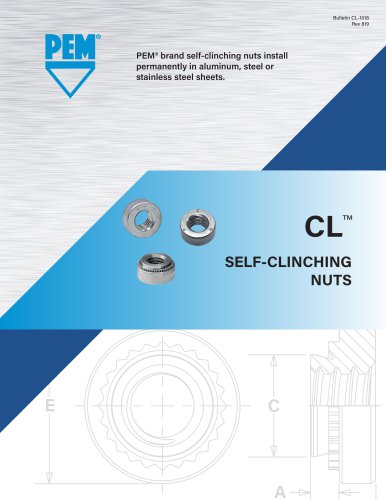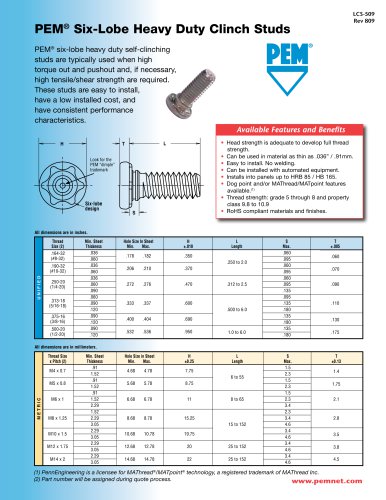
Catalog excerpts

THE SELF-CLINCHING FASTENER HANDBOOK
Open the catalog to page 1
2 How and why self-clinching works . . . . . . . . . . . . . . . . . . . . . . . . . . . . . . 3 Anatomy of self-clinching . . . . . . . . . . . . . . . . . . . . . . . . . . . . . . . . . . . . . 4 Types of self-clinching fasteners . . . . . . . . . . . . . . . . . . . . . . . . . . . . . . . 5 Importance of quality . . . . . . . . . . . . . . . . . . . . . . . . . . . . . . . . . . . . . . . . 6 Reliability in service . . . . . . . . . . . . . . . . . . . . . . . . . . . . . . . . . . . . . . . . . 7 Installation procedure . . . . . . . . . . . . . . . . . . . . . . . . . . . . . . . . ....
Open the catalog to page 3
the that revolutionized production fastening hen K.A. Swanstrom founded Penn Engineering & Manufacturing Corp. in 1942, he did so with a revolutionary new product: an easy-to-install, selfclinching fastener that provides load-carrying threads in metal sheets too thin to be tapped. At first, Mr. Swanstrom produced his innovative design with four machines in a Doylestown, Pennsylvania garage. This simple operation soon gave way to a modern facility in Danboro, Pennsylvania as manufacturers and engineers alike recognized the benefits of self-clinching fasteners. They not only reduced time,...
Open the catalog to page 4
how, why & where to use self-clinching fasteners roadly defined, a self-clinching fastener is any device, usually threaded, that when pressed into ductile metal, displaces the host material around the mounting hole, causing it to cold flow into a specially designed annular recess in the shank or pilot of the fastener. A serrated clinching ring, knurl, ribs, or hex head prevents the fastener from rotating in the host material once it has been properly inserted (see page 4). Thus, self-clinching fasteners become a permanent part of the panel, chassis, bracket, or other item into which they...
Open the catalog to page 5
typical self-clinching nut Direction of Installation Force Head Serrated Clinching Ring Provides Torque Resistance Back Tapered Shank Host Metal Host Metal Cold Flows into Undercut Component Flush Mounted typical self-clinching stud typical self-clinching standoff Host Metal Flows into Undercut Ribs Provide Torque Resistance Flush Mounted Host Metal Flows into Undercut Flush Mounted Direction of Installation Force Hex Head Provides Torque Resistance Direction of Installation Force
Open the catalog to page 6
basic of self-clinching fasteners nuts: Nuts with thread strengths greater than mild steel screws are commonly used wherever strong internal threads are needed for component attachment or fabrication assembly. studs and pins: Threaded blind: Have closed ends and unthreaded fasteners which are used where the attachment must be positioned before being fastened. spacers & standoffs: Used where it is necessary to stack or space components away from the panel. Thru-threaded or blind types are generally standard. flush fasteners: When installed, these fasteners are completely flush within the...
Open the catalog to page 7
of self-clinching fasteners n order request comes to the desk of the buyer or procurement individual with the words PEM® “or equivalent” written next to a specification for self-clinching fasteners. Although a review of the manufacturer’s basic specifications will undoubtedly turn up a shopping list of “equivalents,” a purchase made on the basis of lower price alone may prove installed cost ... more costly in the long the bottom line run. When a designer investigates the desirability of using self-clinching fasteners, his calculations must offer a true picture of cost. If integral fasteners...
Open the catalog to page 8
of a self-clinching fastener he reliability of a self-clinching fastener in often with values exceeding the ultimate torsional service depends on many factors, beginning strength of the mating screw or nut. with a properly sized hole, the thickness and hardness of the host panel, A second reliability measure is pushout. RELIABILITY proper installation and design of the Pushout values indicate the axial resistance FACTORS: fastener, and the application where the of a fastener to remove it from the sheet –––––––––––– fastener is used. opposite to the direction from which it was • properly...
Open the catalog to page 9
installation procedure ast, simple installation saves time and money on the assembly line. In just three easy steps, self-clinching fasteners can be installed with any parallel acting press that can be adjusted to optimum installation forces. First, insert the shank or pilot of the fastener squarely into a previously punched, drilled, or cast hole. Next, apply force until the head of the nut contacts sheet. Some types of fasteners will be fully installed when the head is flush within the sheet. Because the installation equipment generates no excess noise or pollution, the fasteners can be...
Open the catalog to page 10
installation problems and solutions possible cause Fastener not seated squarely – reduced holding power. • Punch and anvil faces are not parallel. • Panel cocked during installation. • Ensure that punch and anvil are flat and parallel and hard. • Ensure that large panels are held perpendicular to punch and anvil. Poor holding power – fasteners fall out of panel. • Inadequate installation force. • Panel too hard for fastener material. • Countersunk hole in panel. • Seat fastener against shoulder by applying more force or changing shut height of press. • Specify appropriate fastener material...
Open the catalog to page 11
other considerations AUTOMATED ASSEMBLY Since all self-clinching fasteners must be squeezed into place, any press or vise that provides the necessary parallel force may be used to install them. A PEMSERTER® automated press should be considered for high volume installations. PEMSERTER presses are specifically designed to feed self-clinching fasteners automatically into punched or drilled holes in sheet metal, seating them correctly with a parallel squeezing force. Feeding rates are five to six times faster than manual insertions, and installation force is adjustable to compensate for...
Open the catalog to page 12All PENN Engineering catalogs and technical brochures
-
SO
12 Pages
-
LN
24 Pages
-
FH
32 Pages
-
FE
6 Pages
-
CL™
16 Pages
-
CH 1217
6 Pages
-
B 916
4 Pages
-
ALA 1217
4 Pages
-
Index 118
8 Pages
-
SF 1115
8 Pages
-
SK 814
6 Pages
-
SO 1214
12 Pages
-
SS 416
24 Pages
-
SSA 913
6 Pages
-
TD 415
6 Pages
-
VM 715
6 Pages
-
WN 1015
4 Pages
-
RA 215
8 Pages
-
PF 415
44 Pages
-
MPF 116
16 Pages
-
LN 414
20 Pages
-
K 1015
20 Pages
-
FH 116
32 Pages
-
FE 315
6 Pages
-
F 1214
4 Pages
-
CL 814
16 Pages
-
B 814
4 Pages
-
CH 1115
6 Pages
-
ALA 314
4 Pages
-
Index 914
6 Pages
-
Self-Clinching Studs/ Pins
32 Pages
-
Self Locking Fasteners
20 Pages
-
microPEM® Fasteners
16 Pages
-
Right Angle Clinch Fasteners
8 Pages
-
Snap-Top®
6 Pages
-
SMTPF 1015
2 Pages
-
PEMSERTER® Presses
16 Pages
-
StickScrew® System
4 Pages
-
Automotive Components
8 Pages
-
Threaded Inserts for Plastics
20 Pages
-
Access Hardware
44 Pages
-
Self-Clinching Nuts
12 Pages
-
Quick Product Locator
6 Pages
-
self-locking fasteners
20 Pages
-
PEM® Heavy Duty Clinch Studs
2 Pages
-
Blu-Coat? Thread Mask
1 Pages
-
PEM microPEM® TackPin? Fasteners
12 Pages
-
Heat Sink Mounting System
4 Pages
-
Turret Tool System
2 Pages
-
PEMSERTER Series 4 Press
2 Pages
-
In Die Feeding System
4 Pages
-
PEMSERTER Series 2000 Press
2 Pages
-
PEMSERTER Series 3000 Press
2 Pages
-
Atlas Type AEKC
1 Pages
-
Atlas Condensed Catalog
4 Pages
-
Self-Clinching Standoffs
12 Pages
-
SpotFast® Fasteners
8 Pages
-
Flush Self-Clinching
4 Pages
-
PEMSERTER Catalog
16 Pages
-
StickScrew® System
4 Pages
-
Self-Clinching Cable Tie Mounts
6 Pages
-
SpotFast® Fasteners
8 Pages
-
Spinning Clinch Bolt
4 Pages
Archived catalogs
-
Product Guide
12 Pages

































































































